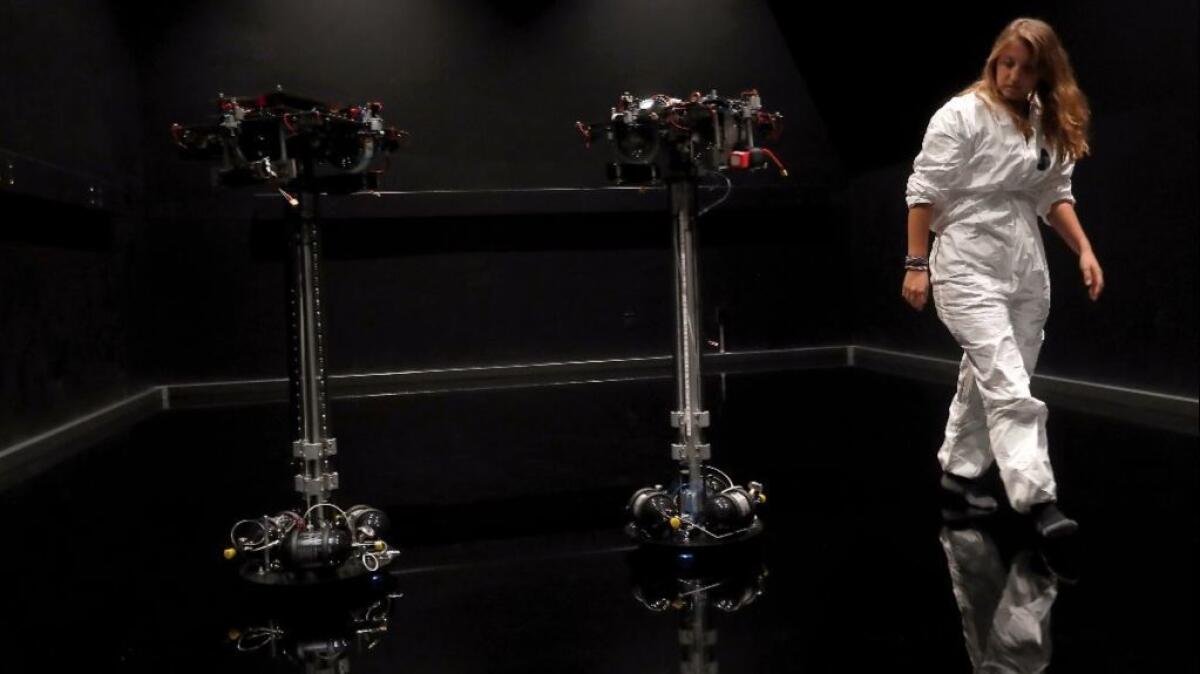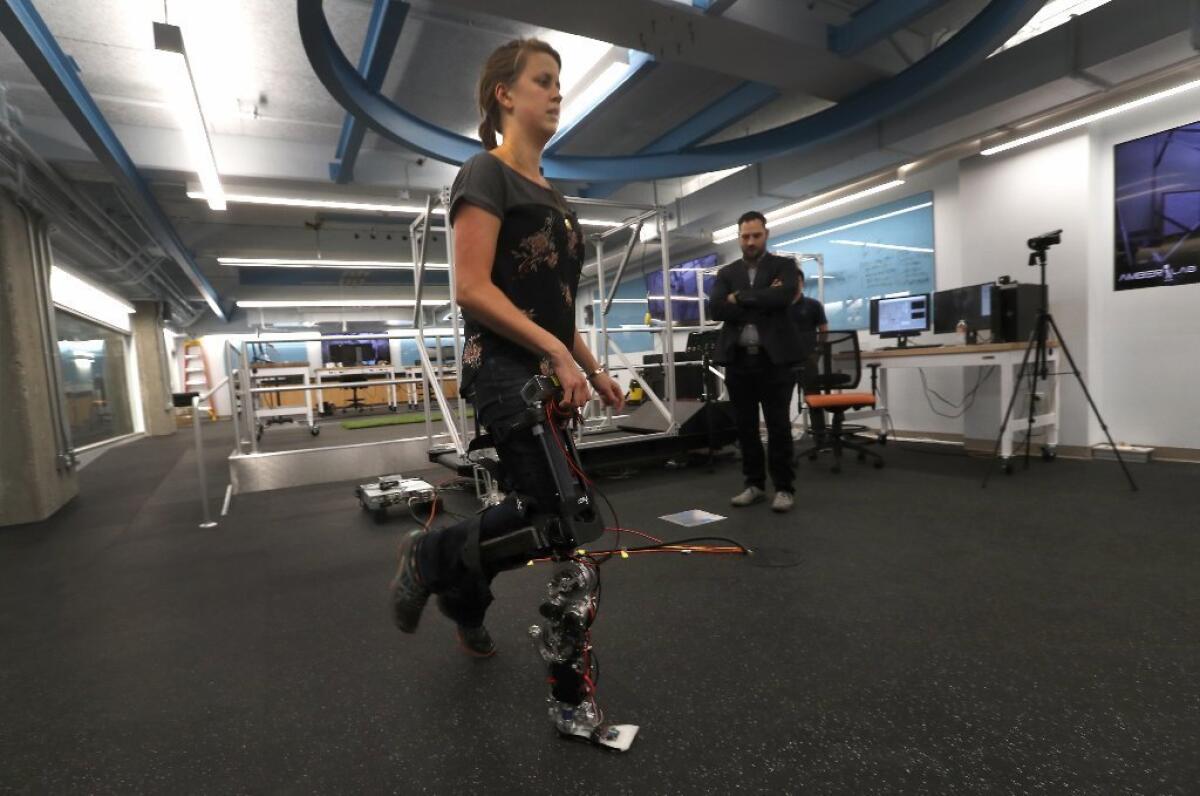Caltech opens a drone lab, with big ideas to improve how robots work with humans

On Tuesday, Caltech opened its new Center for Autonomous Systems and Technologies (CAST), where scientists hope to make these kinds of technological leaps. (Mel Melcon / Los Angeles Times)
- Share via
The mechanical clack, clack, clack of an orange robot on the march brought
One day, students and researchers hope, a robot much like this one will be able to hike the Pacific Crest Trail, guided and guarded by a similar swarm of drones. They will scout the territory ahead and feed the robot information on where to go and how to adapt to ice, sand, mud and other challenges along the 2,600-mile path from Mexico to Canada.
Such a robot would have to “walk places it has never been before,” learning as it goes, said Aaron Ames, a professor of mechanical engineering and control and dynamical systems. First the Pacific Crest Trail, then maybe Mars.
On Tuesday, Caltech opened its new Center for Autonomous Systems and Technologies (CAST), where scientists hope to make these kinds of technological leaps.
The goal is to improve the ability of drones and robots to think and react independently. The more that happens, the more they will be able to help humans gather big data, respond to disasters and explore space, the deepest parts of the ocean and other unreachable corners of the world.
Artificial intelligence is already deciphering online shopping habits. Robots can automatically clean floors. Streets filled with driverless cars are not far in the future.
"Most systems today are very good at solving, very rapidly, the problems that they have been trained to solve. But if you throw something unknown in front of them, they get confused. ... The systems are basically trained so much that they cannot see outside the box," said Morteza “Mory” Gharib, the new center’s director and a professor of aeronautics and bioinspired engineering.
At the center, he said, “it’s not just ’think outside the box.’ There is no box.”

More and more students are interested in studying automation and its myriad applications, and institutions are taking notice.
USC has revamped its old robotics lab, turning it into a center focused on autonomous systems research, and MIT recently announced a $52-million building renovation with a similar aim.
Caltech’s center brings together experts from NASA’s Jet Propulsion Laboratory and multiple fields, including aeronautics, machine learning, geology, planetary science and computer science. Its researchers are already tackling what Gharib called “moonshots:” big-picture challenges that stretch even a researcher’s sci-fi imagination: the Pacific Crest Trail project, a self-flying ambulance that could go 150 mph, a swarm of camera-equipped drones able to fly together or apart in order to create large-scale maps or images.
The idea for the center first took shape about 2½ years ago. Students, postdoctoral researchers and faculty were asked to conceptualize what it might be like.
One of their ideas that is now a reality is what Caltech calls the tallest indoor drone arena of its kind. It is three stories high and was created by enclosing a former courtyard tucked between two aerospace buildings. Inside the space, a wall of 1,296 fans can generate winds up to 44 mph. A side wall of 324 fans can create a crosswind. The arena can mimic any wind condition, even a hurricane vortex, and replicate fog and rain — to train drones to adapt to changing environments.

In the center’s assembly room, researchers can train robots to walk on an 85-foot-long oval track. In the space robotics lab, students can test their designs in an enclosed area that simulates the frictionless motion of flying in space.
“To have a facility that is this advanced in academia is very unusual,” said Lorraine Fesq, chief technologist for JPL’s systems engineering and formulation division. At the center, she said, students will have to be trained to understand the entire process of creating a robotics system, from mathematical proofs and algorithms to the actual mechanical design and construction. “We hire them, and we have them work over the summer and during the school year to help us ... on these projects.”
In the advanced mobility lab on Monday afternoon, some students worked on limbs for a hopping robot. One walked across the room with a prosthetic leg strapped to her right knee, testing how the responsive machinery anticipated her gait.

Outside the lab, doctoral students Jacob Reher and Xiaobin Xiong took the orange robot, named Cassie, for a walk around campus. They avoided grass and dirt — terrain that Cassie is not yet sophisticated enough to manage.
In the outside world, Reher said, there are “all kinds of disturbances that you can't account for, that you don't usually interact with in the labs.” Before the center opened, he said, most of the robotic testing was just walking on a treadmill in a regular lab.
“Now we can really try some new things,” he said. “When you have a center that's dedicated to robotics, where you get a collaboration going between people who usually wouldn't be working together, it spawns some really great ideas.”
Follow @RosannaXia for more education news
Sign up for Essential California
The most important California stories and recommendations in your inbox every morning.
You may occasionally receive promotional content from the Los Angeles Times.








